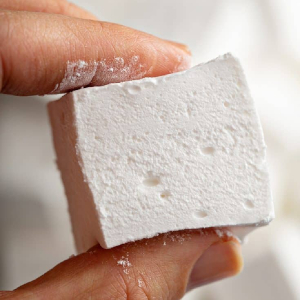They’re an all-season treat, and one everyone can relate to. I still consider every marshmallow I encounter a thing of wonder… But I was amazed to learn what an ancient – and at one point, even godly – delicacy they originally were…
 A classic, gooey, messy S’More: As it should be; hot of the campfire!
A classic, gooey, messy S’More: As it should be; hot of the campfire!
The marshmallow is an all-season, indoor-outdoor treat everyone loves. They can be enjoyed actively or passively. Even the youngest kids go, “Ooooh! Aaaah!” when you pull them out…
Unique
The marshmallow is, in a single, well-chosen word, unique. There’s nothing else like it in texture or flavour. Nothing ‘whiter’ in the entire food kingdom. There’s nothing more intriguing in its deceptive simplicity…
And it’s also a versatile sweet you can pop into your mouth as-is, or combine with other ingredients to make such classics as S’Mores or Rice Crispies Treats. I would go as far as to say that anything you can make with them will be an instant classic.
Surprising history
Did you know that the marshmallow has been known and loved – even worshiped – for at least 4,000 years?
“Ancient Egyptians were the first to enjoy [the] gooey treat now called marshmallow as early as 2000 BC. [It] was considered very special and […] was reserved for gods and royalty,” the National Confec-tioners Association (NCA) reveals. “[The earliest] marshmallow was made from the mallow plant (Athaea officinalis) that grows wild in marshes.”
What the ancient Egyptians knew as ‘marshmallow’ bears little resemblance to the candy we love today.
“The Egyptians squeezed sap from the mallow plant and mixed it with nuts and honey. However, no one knows [for sure] what the candy looked like in those times.”
‘Modern’ marshmallows
The French introduced the marshmallow to Europe in the mid-1800s. Confectioners whipped sap from the mallow root by hand into a fluffy, meringuey consistency, and let it set in special moulds. It was in instant success. Candy makers had a hard time keeping up with the demand.
Looking for a more efficient, faster way to make marshmallows, confectioners came up with what’s known as the ‘starch mogul’ system in the late 1800s. In place of the less-available, temperamental mallow root, they used widely available modified cornstarch and gelatin to create a more-stable treat.
Across the pond…
The marshmallow came across the pond, to North America, in the early 1900s. It was then that devel-opment took a couple of major tuns. Did you know that early commercial marshmallows were usually square or rectangular? Left to set in square pans and then cut into cubes? (See photo, top of page.) It was only with the development of an extrusion process in the 1950s that they started showing up round. That’s also when mini marshmallows were first offered.
International classics…
The first official published reference to S’Mores dates back to 1927, when the campfire treat was fea-tured in Tramping and Trailing with the Girl Scouts. Since then, S’Mores have become a household word, and are allegedly responsible for the sale of almost as many marshmallows as…
Rice Crispies Treats, “…invented in 1939 by Kellogg Company employees Malitta Jensen and Mildred Day ‘in the Kellogg kitchens in Battle Creek, Michigan, as a promotional vehicle for the cereal’.”
My take
Though more associated with spring, summer and fall hikes and weekends at the cottage, be sure to take a bag or two of marshmallows with you cross-country skiing, snowshoeing or ice skating this Holiday break. Build a small campfire and enjoy them the classic, way – golden and bubbly, hot off the tip of a fallen twig!
~ Maggie J.

